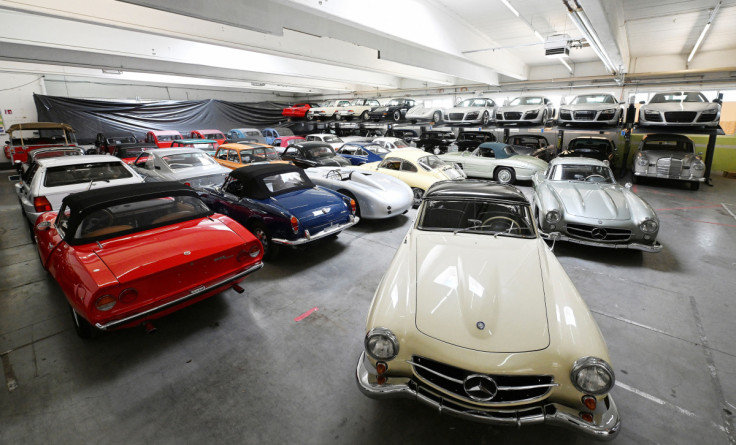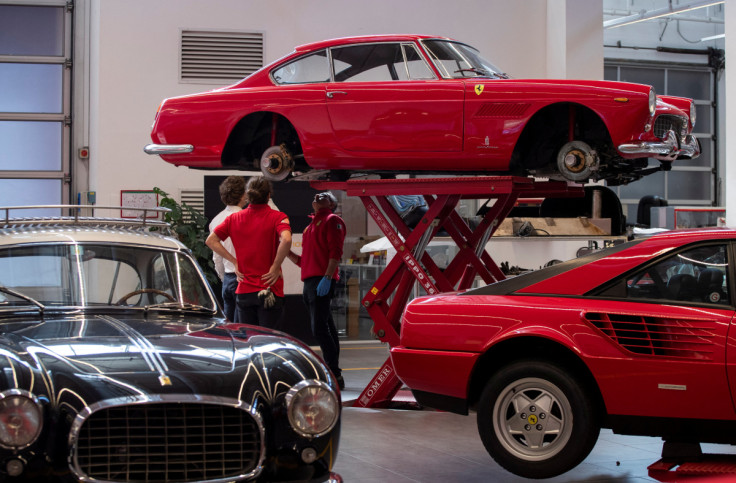Ferrari Fever? Classic Cars Roar Into Investment Funds

In 1977, a Ferrari owner offloaded his 1962 250 GTO because his wife complained it was too noisy, recounts Andrea Modena, head of Ferrari's classic car division. It was either her or the car.
"Nowadays, I'm not sure the wife would have won out."
Times have indeed changed. In 2018, the same Ferrari model became the most expensive car ever sold when it fetched $48 million at auction. Last year, that record was flattened by a 1955 Mercedes-Benz 300 SLR Uhlenhaut Coup? that raced to 135 million euros ($149 million).
These kind of megadeals are at the vanguard of billions of dollars of annual spending on classic cars globally in a wave of investment in this alternative asset.
Vintage cars have risen 185% in value over the past decade, outstripping the growth of luxury rivals wine, watches and art, and ranking second only to rare whiskies, according to Knight Frank's 2023 wealth report.
The market has expanded beyond a comparatively small community of collectors to include investors drawn by the prospect of high returns plus a lack of correlation with mainstream portfolio assets such as stocks and bonds.
"We've been monitoring the market for a long time," said Giorgio Medda, CEO and global head of asset management at Italy's Azimut. "The track record of the past 30 years tells us classic cars have become a financial asset class we want our clients to have in their portfolios."
This year, the asset manager is launching what it describes as the world's first "evergreen" fund to invest in vintage vehicles, and says it'll only bet on cars worth more than 1 million euros each.
Advised by Alberto Schon, head of Ferrari and Maserati dealer Rossocorsa, the fund says it will pick vehicles with a unique history.
While Azimut's fund will have no end date and can receive new money indefinitely, small Swiss asset manager Hetica Capital launched a 50 million euro 'closed-end' fund in 2021, which it also said was the first of its kind.
The Hetica fund, which is targeting returns of 9%-15% after seven years, has bought a dozen cars so far and aims to get to 30-35 cars by the fifth year, leaving the last two years to sell the vehicles and pay investors.
The plans are bold.
"We've seen more than 100 attempts at setting up funds in the past. Nobody managed to build both a diversified investor base and a diversified car portfolio," said Dietrich Hatlapa, founder of classic car research house HAGI, which supplies the sector data used by Knight Frank.
It's also not a sector for the financially faint-hearted.
Registered in Luxembourg, both the Azimut and Hetica funds have a minimum entry investment bar of 125,000 euros.
"We get loads of calls from people who're looking to invest 1,000-2,000 euros and we have to turn them down," said Walter Panzeri who runs Hetica's Klassik Fund.
Moreover, a small scratch or dent, or a replacement part, can deal a heavy financial blow. For example, replacing just the bumper of a rare vintage car can cost $15,000, said Modena.
Graphic: Investments of Passion -
KEEPING THE CARS ALIVE
Running costs for car collections, including hefty storage and insurance fees, could easily amount annually to 5-6% of the portfolio's value, according to Florian Zimmermann, who started buying vintage cars when he worked at Mercedes-Benz and has since built a collection of 300 vehicles with a partner.
"It's getting harder and harder to find the proper mechanics to keep these cars alive. And you have to spend quite an amount of money to keep all these cars in running condition," he said.
Indeed investment funds managing car portfolios can be a money-spinner for the classic car divisions of automakers, which not only provide repairs and parts, but also certify the authenticity of vehicles to take part in shows and competitions.
The certification process alone can cost around 20,000 euros, according to Peter Becker of Mercedes-Benz Classic who said only the carmaker's experts, with access to its archives, could confirm the originality of a classic model.
Nonetheless, the classic car market is expanding as the number of wealthy people also rises; the value of vintage cars grew 25% in 2022, their strongest performance in nine years and second only to art's 29% increase, according to Knight Frank.
Classic vehicle insurer Hagerty estimates there are about $80 billion collector vehicle transactions a year globally, including all auctions and private sales.
While North America remains the largest market for auctions, with Hagerty recording $3.4 billion in auction sales in 2022 versus $774 million in 2007, Zimmermann said a growing number of buyers had emerged in recent years in the Middle East, India and China.
'THEY'LL BE CULT OBJECTS'
The global race to renounce combustion engine cars will only serve to heighten interest in these relics of a vanishing era, say some market players.
"Electrification will favour classic cars," said Cristiano Bolzoni, head of Maserati's vintage car unit Maserati Classiche. "Over time they will become cult objects."
Ferraris are the most prized vintage autos, according to Adolfo Orsi, founder of the Classic Car Auction Yearbook which has been tracking auction sales data since 1990, who described them as "absolutely the blue-chips of this sector".
Ferraris commanded an average value at auction of $589,000 in 2021-22, followed by Mercedes-Benz cars on $378,000 and Porsches with $348,000.
"The classic car community has changed tremendously over the past five to 10 years," Zimmermann said. "Once it was only people who knew the cars inside out. But over time others simply thought: I like these cars, I can afford one and I don't lose money by buying it."


© Copyright Thomson Reuters 2024. All rights reserved.





















